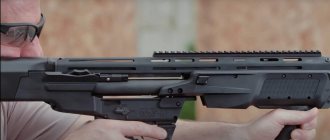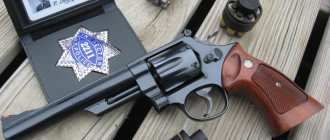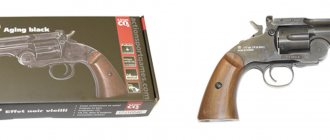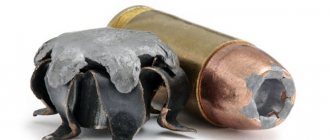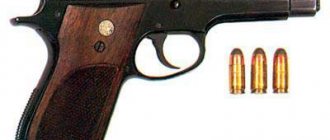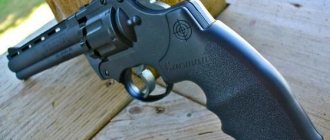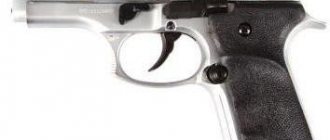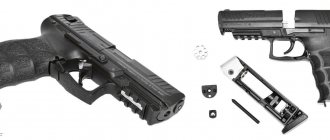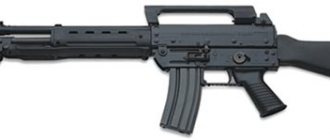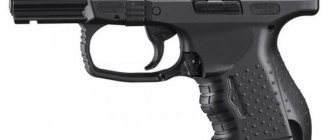Revolver Model caliber .38-200 "British Service" (1940-1945) (.38-200 British Servce)
Known to the British military as the No. 2 Smith & Wesson pistol, this revolver was a standard Military & Policy model chambered for the English .38 caliber cartridge with a 200 grain bullet. The total number of such revolvers, differing only in external decoration and the shape of the grip cheeks and produced for Great Britain and the countries of the British Commonwealth, amounted to 1,125,000 pieces. Design changes made during production were minor, with the exception of the introduction of a new trigger locking device in 1944.
Quite soon, revolvers of this model gained a reputation for frequent misfires when firing, which was explained by the harder primers of English ammunition. This drawback, however, turned out to be easily eliminated by adjusting the mainspring, the force of which could be changed by rotating a special screw on the front end of the handle.
After such tuning, the Smith and Wesson revolvers served almost flawlessly and over time became even more popular than the English Enfield revolvers. The .38-200 remained in British Army service until almost the early 1960s.
Revolver Model 14 K-38 “Masterpiece” (1946—1973) (K-38 Masterpiece, Model 14)
This target variant of the Model 10 Military and Police featured a longer barrel and an adjustable sight. Beginning in 1959, versions with a different barrel length appeared, and in 1961 it released a version with a reduced response time of a single-action trigger mechanism.
The similar Model 15, a variant of the .38 caliber revolver with a 2- or 4-inch barrel, was intended for use as a pocket gun but, oddly enough, retained the target sight. Model 36 Chiefs Special in .38 caliber (1950 to present) (.38 Chiefs Special).
The revolver of this name, offered to buyers with a 2- or 3-inch barrel, was the first short-barreled weapon to appear after 1945. There are also two modifications: model 37 “Airweight” with a frame made of lightweight alloy and model 60 “Stainless”, made of stainless steel.
Webley .38 Mk IV / Mk IV Target Model revolver
| Webley .38 Mk IV |
During World War I, the standard weapon of the British military was the .455 caliber Webley revolver.
It was an effective weapon, but too heavy and large, and firing it required skill, long training and practice. For this reason, after 1919, the command of the British Army decided to abandon .455 caliber cartridges and replace revolvers created for this cartridge with models of a smaller caliber, but with equally high combat qualities. Webley .38 Mk IV
After numerous experiments and tests, it was decided that the 38-caliber weapon was optimal, since its stopping effect remained sufficient, and the relatively weak recoil significantly increased the ability to conduct aimed fire. At the same time, the weapon became lighter and easier to shoot from, and the training time for shooting was also reduced.
In response to British Army demands for a new .38 caliber short-barreled weapon, the Webley .38 Mk IV revolver was developed and introduced in 1929.
The new Webley Mk IV .38 caliber revolver was a modification of the Army's Webley Mk IV .455 caliber model with improvements found on the Webley Mk V and Mk VI models, as well as other design changes such as the frame latch, cylinder lock, hammer and frame shape.
Structurally, this weapon was a revolver with a frame that could be broken for reloading and the simultaneous extraction of all cartridges.
The 4-inch (102 mm) long barrel with 7 right-hand rifling had a top rib and a muzzle boss with a permanent front sight.
The frame was locked using a Green system lock, which looked like a U-shaped bracket, with an upper crossbar gripping the shank of the upper half of the frame. The lock was controlled by a lever on the left side of the frame, when pressed, the crossbar moved back and released the upper part of the frame. On the right side of the frame there was a V-shaped flat spring of the lock openly located.
The trigger mechanism is of the hammer type with an open trigger having a “rebound” action, double action.
| Webley .38 Mk IV being reloaded |
The weapon was fed with ammunition from a drum with a capacity of six rounds. Extraction of spent cartridges was carried out automatically - when you pressed the frame locking lever, the revolver broke, the drum opened, and a spring-loaded sprocket pushed out the spent cartridges. The weapon was also loaded in the “broken” position.
On the lower boss of the barrel, in front of the drum, there are horizontal shelves designed to conveniently guide the weapon into the holster and reduce snagging on its edges with the drum.
Sights are open type. The semicircular front sight is located in a slight ridge at the muzzle, and the rear sight was a cutout in the upper part of the frame lock lever.
The handle had a trapezoidal (flared) shape and a ring for a safety strap. The handle cheeks with fine notches are made of ebonite.
| Webley .38 Mk IV |
The Webley .38 Mk IV was a durable, compact, lightweight revolver that was comfortable and reliable to use. However, in 1932, the Enfield No 2 Mk I revolver in .38 caliber, developed by the Royal Armories, was adopted by the British Army, which was created taking into account the developments of Webley and at first glance was almost similar to the Webley .38 Mk IV.
| Caliber, mm | 9 (.38) |
| Length, mm | 235 |
| Barrel length, mm | 102 |
| Weight without cartridges, kg | 0.76 |
| Drum, count. cartridges | 6 |
At this point, more than forty years of cooperation between Webley and the British military department was terminated. In the absence of government orders, the .38 caliber Mk IV revolver was aimed at the commercial and foreign markets and was supplied in significant quantities to police forces throughout the British Empire.
In 1940-1945, after the outbreak of the Second World War, the British Army acquired more than 100,000 of these revolvers, which were produced in parallel with the same model Enfield No 2 Mk I. During the Second World War, the Webley .38 Mk IV was in service with England as weapons of a limited standard and were used until 1963.
| Webley .38 Mk IV with 5 in (127 mm) barrel and safety |
The Webley .38 Mk IV revolver was typically produced with a 4-inch (102 mm) barrel length, although models were produced in separate batches with a 5-inch (127 mm) barrel length, as well as with a push-button trigger safety located in the heel of the frame behind the trigger. In addition, targeted modifications of these weapons were sold on the commercial market.
Webley .22 Mk IV Target Model with 6 inch (152 mm) barrel length
The Webley .38 Mk IV Target Model variant of the standard .38 caliber revolver was produced from 1929 until the mid-1950s. It was distinguished by particularly careful fitting of parts during the production and assembly process and the presence of a sight adjustable in the horizontal plane. Revolvers produced after 1945 were equipped with 6-inch barrels.
1929 also saw the introduction of the Webley .22 Mk IV Target Model. This conversion of the .38 caliber revolver to chamber the .22 caliber rimfire cartridge, which turned out to be very successful, inherited the cylinder and barrel size from the centerfire model. Therefore, during shooting practice using cheaper rimfire ammunition, the shooter experienced the same sensations as when using real live ammunition. The revolver was especially popular with the police.
| Webley .22 Mk IV Target Model with 6 in (152 mm) barrel length |
Revolver Model 40 "Centennial" caliber .38 (1957-1974) (.38 Centennial, Model 40)
This centenary model was similar in appearance to the New Depache revolver, the last of which was released in 1940, but differed in its tilting cylinder.
At the same time, the Model 42 with a lightweight alloy frame appeared, but its production was discontinued even earlier than the production of a revolver made entirely of steel. However, this basic model was brought back into production in the late 1980s; The new revolver with a barrel length of 2 inches was called the Centennial Model 640.
Collector's cartridge. .38 Smith & Wesson.
In 1877, the .38 Smith & Wesson revolver cartridge appeared on the arms market, filled with black powder, which was later replaced by smokeless powder. This cartridge was most often used in revolvers with a double-action trigger with a tilting cylinder, such as the Smith & Wesson Regulation Police model.
The .38 Smith & Wesson cartridge was designed for Smith & Wesson's break-action revolvers (in this case the .38 Single Action) which were very popular in the last decades of the 19th century. The year of manufacture 1877 indicates that this cartridge was loaded with black powder, which, like many other ammunition, was later replaced by more modern smokeless powder.
No other revolver cartridge had more names. The .38 Smith & Wesson cartridge is also known as the .38 Colt New Police, .38 Super Police, and the English standard .38/200 cartridge, where "200" denotes a 200-grain (13 g) bullet weight. Ammunition. 38 Smith & Wesson gained a worldwide popularity that only began to wane after World War II. The .38 Special cartridge was introduced by Smith & Wesson in 1902 for K-frame revolvers. It began to replace the .38 Smith & Wesson cartridge in small frame models.
The best times of the latter began with the advent of revolvers with a double-action trigger and a drum that tilted to the side. In 1905, Colt introduced the Police Positive .38-caliber revolver. For him, the .38 Smith & Wesson cartridge was modified and named .38 Colt New Police. This was followed by the successful Police Positive Special revolver. On March 5, 1917, Smith & Wesson began producing the Regulation Police revolver chambered in .38 Smith & Wesson. Also, other weapons manufacturers in the USA and Europe produced various models of revolvers for this ammunition. The .38 Smith & Wesson cartridge was especially widespread in the countries of the Commonwealth (an interstate association of Great Britain and most of the former English dominions, colonies and dependent territories. - Translator's note), as well as in South America.
Purely English solution
After World War I, the British War Department began searching for a successor cartridge for its armed forces to replace the .455 Webley, which experts assessed as overly powerful. Based on this, the new Webley break-frame revolver was chambered for the .38 Smith & Wesson cartridge. However, the original cartridge from the USA was loaded in accordance with the needs and wishes of British customers. This is how the .38/200 ammunition appeared, equipped with a lead bullet with a rounded head weighing 200 grains (13 g). In 1937, a number of comments were made that the lead bullet was not suitable
At one time, the .38 Smith & Wesson cartridge was very popular among owners of revolvers with double-action triggers with small frames.
Hague Convention of 1907 “On the Laws and Customs of War”. The consequence was that the cartridge began to be loaded with a full-jacket bullet with a rounded head weighing 178 grains (11.5 g). In 1932, in the British army as standard ammunition for Enfield No. 2 the .38/200 cartridge began to be used; at the same time, the Webley revolver was not withdrawn from service. To these two models, during World War II, Smith & Wesson revolvers were added with a double-action trigger, with a medium-sized frame and a tilting cylinder, which received the designation British Service. Between 1940 and 1945, 568,204 British Service revolvers were produced. In connection with the fulfillment of a contract from the British Ministry of Defense, Smith & Wesson was even forced to suspend production of the standard .38-caliber Military & Police revolver, intended for the US army and police. April 24, 1942 became the date of production of the millionth copy of this model, after which a new accounting began and the letter V was placed before the serial number of the weapon. In Great Britain, revolvers with such serial numbers received the designation Victory Model. Also in this case, in addition to the standard .38-caliber revolver for the US Army and Police Military & Police, a model was simultaneously produced for the British Armed Forces.
During World War II, a number of small changes were made to the design of the revolver. The most significant of these was the new trigger locking system, installed in revolvers with serial numbers after V 769000. In addition, the letter S was added to the letter V. The last revolver produced during the war had the serial number VS 811119.
The .38/200 cartridge for Webley and Enfield revolvers continued to be used by British security forces until the late 1960s. For example, these included the Royal Ulster Constabulary and the Ulster Special Constabulary. In the United States, Smith & Wesson ceased production of .38-caliber revolvers with double-action triggers in the 1970s. Most notably, the Smith & Wesson .38 Regulation Police model was discontinued in 1974. The last model of the Regulation Police .38-caliber J-frame revolver, produced under government orders, was numbered 33 (Modell 33). The cylinder capacity was five rounds, which is typical of various Smith & Wesson small-frame .38-caliber revolvers.
Compared to Great Britain and most former British dominions, colonies and dependent territories, as well as the United States, the .38 S&W cartridge was less common in Central Europe. Currently, revolvers chambered for this cartridge can be found mainly among weapon collectors.
Guaranteed supply
The .38 Smith & Wesson cartridge is currently produced by major ammunition manufacturers and is loaded with lead bullets weighing 145 to 146 grains (9.5 to 9.4 g). It will probably be produced for a long period of time due to the availability of a simply gigantic number of used revolvers. However, you should pay attention to the fact that the cartridges currently available for sale are filled with smokeless powder and cannot be used for firing from weapons designed for ammunition with black powder. Some revolvers simply cannot withstand the increased loads. Of course, the law requires that .38 Smith & Wesson smokeless powder cartridges be fired at reduced loads in weapons designed for black powder ammunition.
Quite modest characteristics
By modern standards, the .38 Smith & Wesson cartridge has rather modest external ballistic characteristics. According to manufacturers, when fired from a weapon with a barrel length of 102 mm (4”), the initial flight speed of a lead bullet with a rounded head weighing 146 grains (9.4 g) is 209 m/s, which corresponds to an energy of 207 J. Currently The .38 Smith & Wesson cartridge is produced by companies such as Remington, Winchester, Magtech and PPU (Serbia).
| | Bullet weight (g/g) | Bullet type | Capsule | Powder charge (g) | Chuck length (mm) | V0 (m/s) |
| Winchester | 140/9,1 | Hornady Lead FP | CCI 500 | 2.2 Rottwell P 804 | 27,2 | 203 |
| Winchester | 140/9,1 | Hornady Lead FP | CCI 500 | 2.5 Hodgdon HP-38 | 27,2 | 211 |
| Winchester | 158/10,2 | Speer Lead SWC | CCI 500 | 3.0 Alliant Unique | 27,1 | 208 |
| Winchester | 158/10,2 | Speer Lead SWC-HP | CCI 500 | 2.6 Alliant Red Dot | 27,1 | 225 |
| Winchester | 158/10,2 | Speer Lead RN | CCI 500 | 2.5 Winchester 231 | 27,2 | 204 |
| Winchester | 158/10,2 | H&N SWC HS | CCI 500 | 2.7 Alliant Red Dot | 27,2 | 229 |
| Weapon tested: Smith & Wesson Modell 33 revolver. Barrel length: 102 mm (4”). Case length .38 S&W: 19.69 mm (775”). Bullet diameter: 9.07 mm (.775”); in accordance with the size table of the Permanent International Commission for the Testing of Hand Firearms - 9.17 mm. Maximum pressure of powder gases when firing the .38 S&W cartridge: 1200 Bar. Maximum chuck length: 31.50 mm (1.240”). Further use of the data given in the table is carried out at your own risk. The author and publisher do not bear any responsibility. |
Problems with caliber
According to the Permanent International Commission for the Testing of Handguns size table, the maximum bullet diameter of the popular and currently popular .38 Special cartridge is 9.12 mm (.359”). At the same time, for the .38 Smith & Wesson ammunition it is 9.17 mm (.361”). This difference is a major concern when handloading .38 Smith & Wesson cartridges. As practice shows, .38 Special ammunition is equipped with bullets with diameters from 9.07 mm to 9.09 mm (from .357” to .358”). However, the .38 Smith & Wesson round would be best suited to a 9.14mm (.360”) bullet. However, they are not sold in specialized stores of large manufacturers. Therefore, we have to be content with bullets for .38 Special ammunition. When loading by hand, special attention should be paid to the tight fit of the bullet into the cartridge case.
The .38 Smith & Wesson cartridge was originally designed to be loaded with black powder, which was later changed to smokeless powder. (Source: size table of the Permanent International Commission for the Testing of Handguns)
The second question is how a slightly smaller bullet diameter affects shooting accuracy. Practice has shown that most modern revolvers with a double-action trigger chambered for the .38 Smith & Wesson cartridge, when using ammunition with a bullet with a diameter of 9.09 mm (.358”), have quite satisfactory shooting accuracy. At least this applies to cartridges with relatively soft lead bullets. The situation is more critical with cartridges equipped with jacketed bullets with a diameter of 9.07 mm (.357”). In this case, when using hand-loaded cartridges, you should pay attention not only to the tight fit of the bullet into the cartridge case, but also to the movement of the bullet along the rifling of the barrel, designed for a .38 Smith & Wesson ammunition bullet of a slightly larger diameter. In any case, it is recommended to conduct a series of test firings. Those who would like to have bullets with the diameter of the original .38 Smith & Wesson cartridge cannot do without casting them themselves. Demand for lead bullets for the new shooting discipline of Cowboy Action Shooting has led to a significant increase in bullet types with diameters ranging from 9.07 mm to 9.09 mm (.357” to .358”). Some of them weigh less than the standard .38 Special cartridge, which is 158 grains (10.2 g).
When shooting the Smith & Wesson Modell 33 Regulation Police revolver, DWJ magazine staff used cartridges loaded with the corresponding Hornady 140-grain (9.1 g) bullets.
In addition to factory ammunition, Starline also sells new factory cartridges. Corresponding sets of dies for manual loading of cartridges are supplied by all major major manufacturers from the USA. The author worked with a set of dies from Lee. All gunpowders used in .38 Special ammunition were used to load the cartridges. Accordingly, this makes it possible to install standard Small Piston pistol capsules.
DWJ findings
These days, the .38 Smith & Wesson cartridge is used primarily in collector's firearms. At one time it was extremely popular among owners of service revolvers. So, mainly before World War II, they were equipped with revolvers produced by Smith & Wesson and Colt. The latest models of revolvers, produced in 1974, were developed by Smith & Wesson to chamber the .38 Smith & Wesson cartridge, initially loaded with black and later smokeless powder. Due to the fact that the .38 Smith & Wesson cartridge was very widespread at one time, components for its equipment are still available in sufficient quantities today. Handloaders should be aware that a .38 Smith & Wesson cartridge should never be chambered with a powder charge designed for the .38 Special cartridge.
Hans J. Heigel Translation by Victor Nazarov
Revolver Model 36 "Ladysmith" caliber .38 (Model 36) (.38 Ladysmith)
The name "Ladysmith" reappeared in the product range in 1989 to designate a completely new range of sidearms, which also included automatic pistols (see below).
In accordance with the requirements of the century, this weapon is not for women, like the previous revolvers of the same name, because it is designed for the powerful .38 “special” cartridge. Five-shot Model 36 revolvers are available with a regular 2-inch barrel or a heavy 3-inch barrel. The handle of this weapon can be either rounded or equipped with figured wooden cheeks made of valuable wood with grooves for fingers.
The Model 60, identical in all respects to the Model 36 revolver, is made entirely of stainless steel.
SMITH AND WESSON.
Model 14-CA (single action) .38 caliber. Based on materials from SMITH & WESSON.
SMITH AND WESSON.
Model 64 .38 caliber stainless steel. Based on materials from SMITH & WESSON.
SMITH AND WESSON.
Model 12 .38 gauge. Based on materials from SMITH & WESSON.
Revolver 9 mm model 547 "military and police" (1980-1985) (9 mm Military & Police)
This experimental model, which remained in production for a relatively short time, was a modification of the Model 10, chambered for the 9 mm Parabellum cartridge, and was intended for military and police forces who traditionally preferred to use revolvers, while wanting the latter to be standardized to the most common cartridges for pistols and submachine guns in the world.
The grip curvature of this revolver was changed to allow the shooter to better control the heavier recoil, although the Model 547 was otherwise a fairly standard six-shooter with a 3- or 4-inch barrel—typical of the .
This model never gained any particular popularity, and its further production was soon deemed inappropriate.
Pneumatic revolver Umarex Smith & Wesson M&P R8 (5”)
Umarex Smith & Wesson M&P R8 Specifications:
| Manufacturer: | Umarex (Germany / Taiwan) |
| Guarantee: | 12 months |
| Caliber: | 4.5 mm (.177) |
| Combat prototype: | Smith & Wesson Model 327 M&P R8, S&W (USA) |
| Based on the operating principle (?): | gas-cylinder pneumatics |
| Energy Source: | 12 gram CO2 gas cartridges |
| Muzzle energy (?): | up to 3 J |
| Ammunition: | BB balls 4.5 mm |
| Magazine capacity: | 8 |
| Blowback (?): | No |
| Shot speed: | 120 m/s |
| Material: | body - plastic |
| Trigger mechanism (?): | double acting |
| Shooting mode (?): | semi-automatic |
| Fuse: | non-automatic, push-button sliding switch |
| Sights: | non-adjustable rear sight and front sight |
| Weaver/Picatinny rail: | yes, under the trunk |
| Barrel type (?): | smooth |
| Length: | 267 mm, barrel - 128 mm (5 inches) |
| Weight: | 650 g |
| Equipment (?): | pistol, drum magazine, instructions |
| Certificate: |
Description of the Umarex Smith & Wesson M&P R8 pneumatic revolver:
Smith & Wesson Military & Police R8 is a revolver, as its name suggests, intended for military and police use. About half a century ago, it was in service with the American army and police, along with pistols and revolvers of other models. Umarex has created a pneumatic copy of this revolver with the same name. Thus, this pneumatic revolver copies the appearance of its famous prototype.
The body is made of impact-resistant plastic, it is specially lightweight, its weight is only 620 g. The smooth barrel is steel, since the shooting is carried out with steel explosive balls. The cylinder of the Umarex Smith & Wesson M&P R8 holds 8 rounds. The initial bullet speed is at least 120 m/s. The trigger mechanism of this air pistol has a double action, so you can choose between self-cocking rapid-fire mode and slower, but more accurate shooting with manual pre-cocking.
Carbon dioxide cartridges are charged in the handle of the revolver: you need to press the button located at the bottom of the handle, and its rear surface will open. The drum lock button also functions as a safety lock. If the button is moved to the “forward” position, the drum will open using the internal lever. If the button is pushed back, the inner lever will activate the safety. When the revolver is on the safety, the trigger and hammer cannot be activated.
The revolver's sights are standard mechanical, but there is an under-barrel mount for installing devices such as a laser sight or flashlight. The price of the Umarex S&W Military & Police R8 is very affordable, anyone can afford it.
Video review:
Information about the characteristics, configuration, appearance and color of the product is for informational purposes only.
; they are subject to change by the manufacturer without notice.
In the online store pnevmat24.ru you can buy a Umarex Smith & Wesson M&P R8 (5”) pneumatic revolver with convenient delivery throughout Russia by courier, transport company or Russian Post. We also deliver to Belarus. You can check the price and order the product on the website, by phone or write an e-mail.
